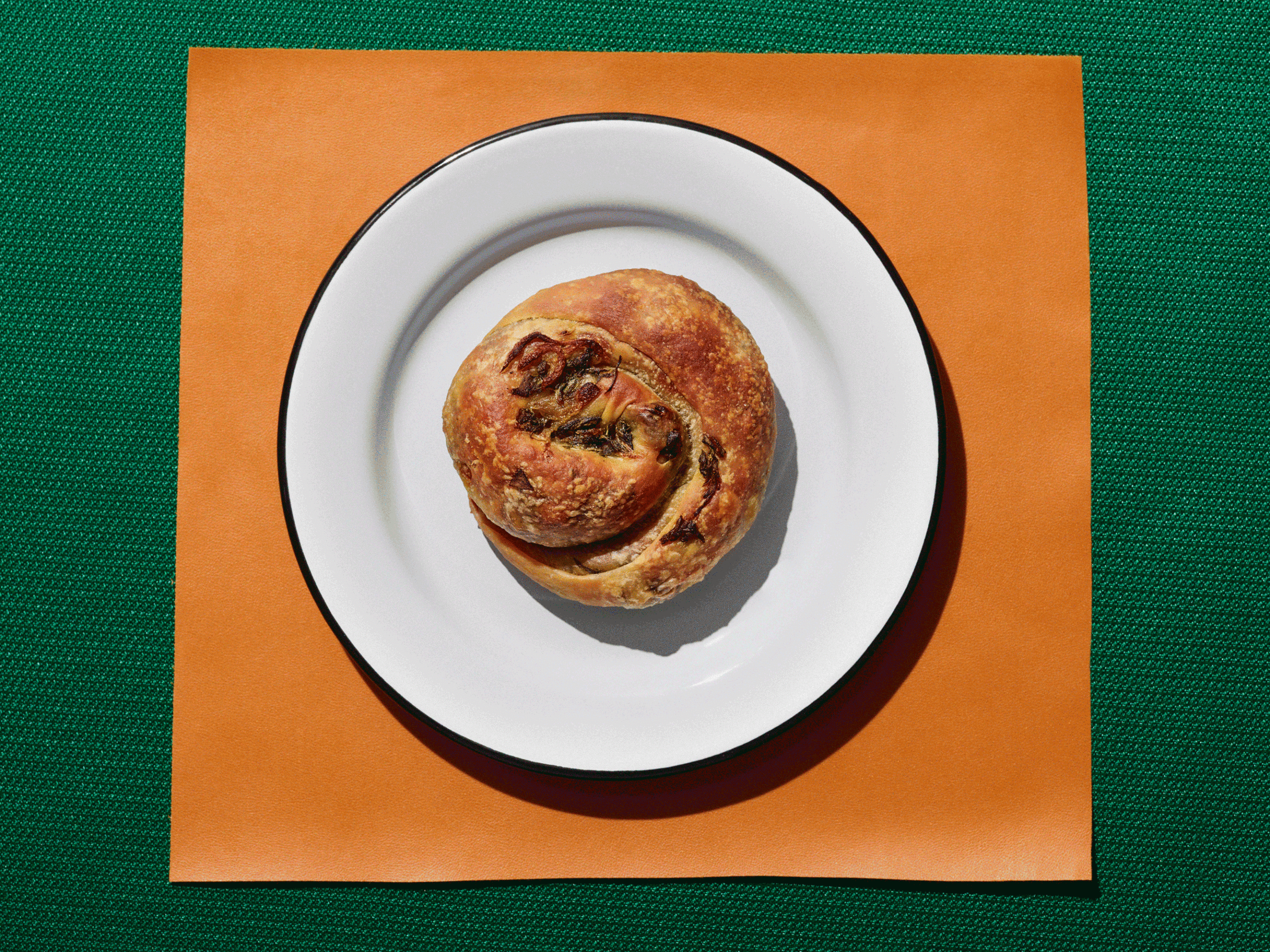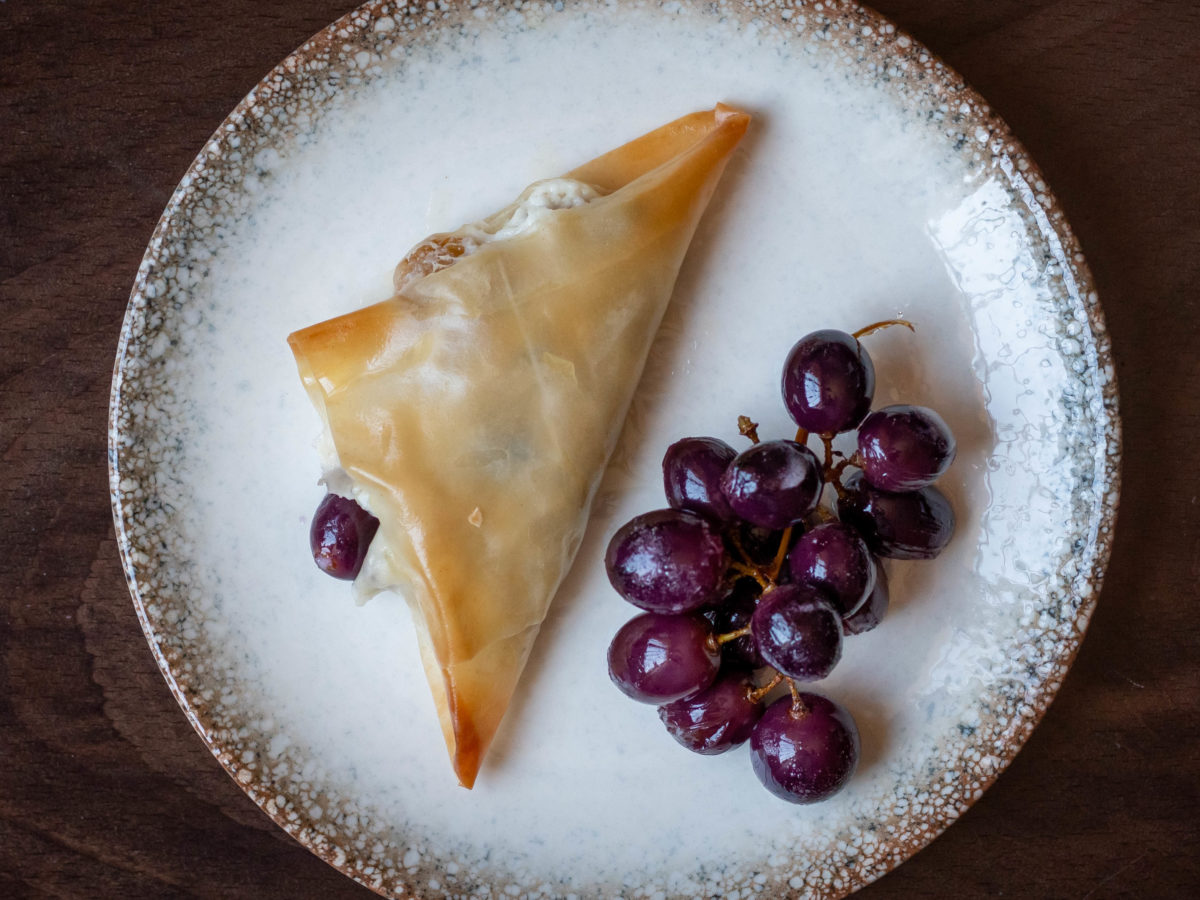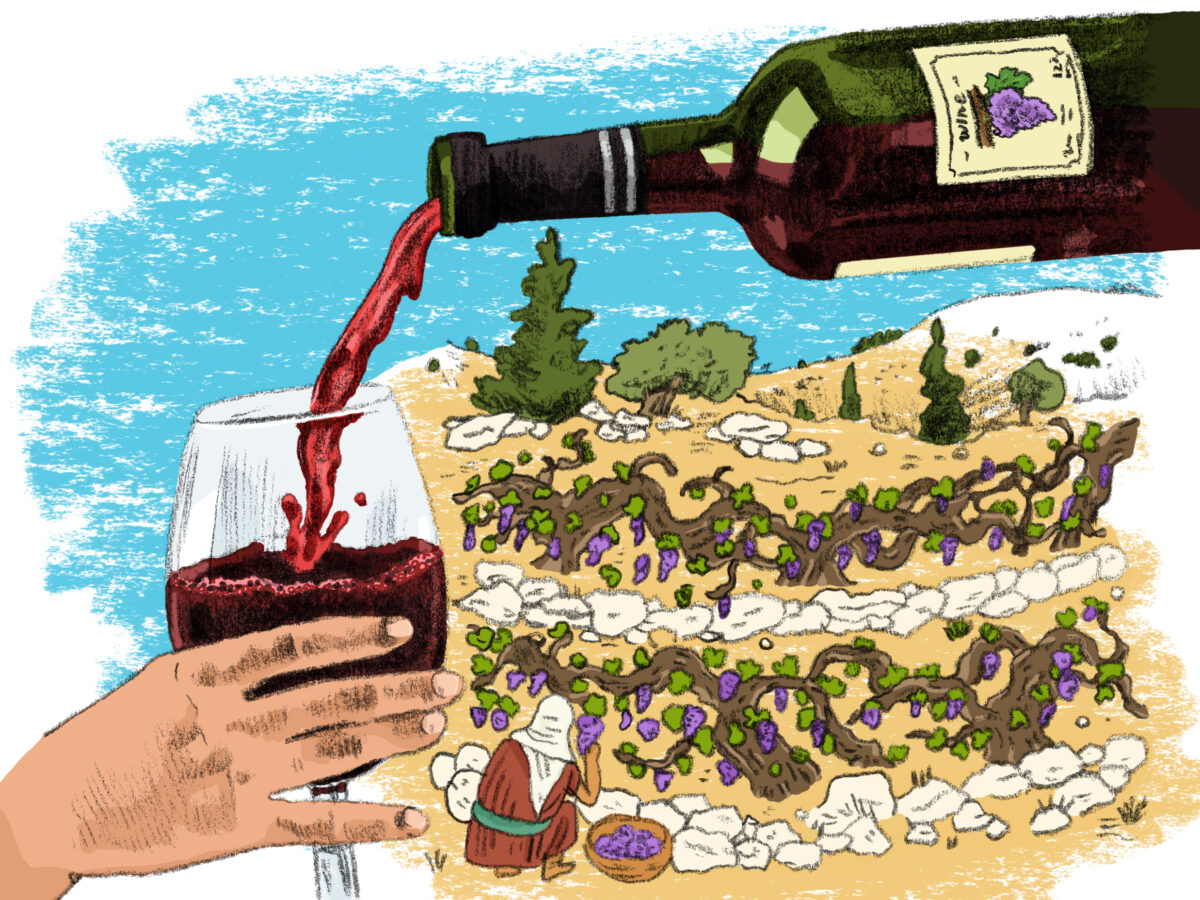Crunchy on the outside, made of thin layers of dough, and usually filled with cheese, with or spinach — and in its local version, potatoes — bourekas have long been an icon of the Israeli food scene. Yet like many other foods, “bourekas are a synthesis of cultures and styles…. that have been transformed and transferred, on their way to becoming a ubiquitous treat in modern Israel,” as Gil Marks writes in his important “Encyclopedia of Jewish Food.” So, how did bourekas get to Israel, and how did they adapt?
A Taste of the Steppes
The origin of burek remains unclear, but two theories seem plausible: according to one, it’s a metamorphosis of the Byzantine plakous, a flat cake that evolved from the Roman placenta, a multi-layered cake filled with cheese and honey or chopped walnuts. The second theory, supported by recent ethnographic research, holds that its origins trace back to Turkish nomads from Central Asia before the seventh century AD.
In Priscilla Mary Işın’s “Bountiful Empire,” she writes that in the times of Sultan Mehmed IV (1648-1687), the imperial council used to meet every two days at the Topkapi Palace. After discussing the empire’s current affairs, they would sit down to a royal feast. And just like the palace itself, the meal was a reflection of the empire’s diversity. Each of the dishes served was grander than the other, but the most distinguished and constant dish of all was the burek, a savory pastry resembling what we now know as water burek or su burek. It was made of layers of yufka dough (similar to filo, only slightly thicker), stuffed with feta, parsley, chicken or minced beef, and sometimes vegetables like spinach, leek, or zucchini. The delicate yet rich pastry was the elegant national dish of the Ottoman empire.
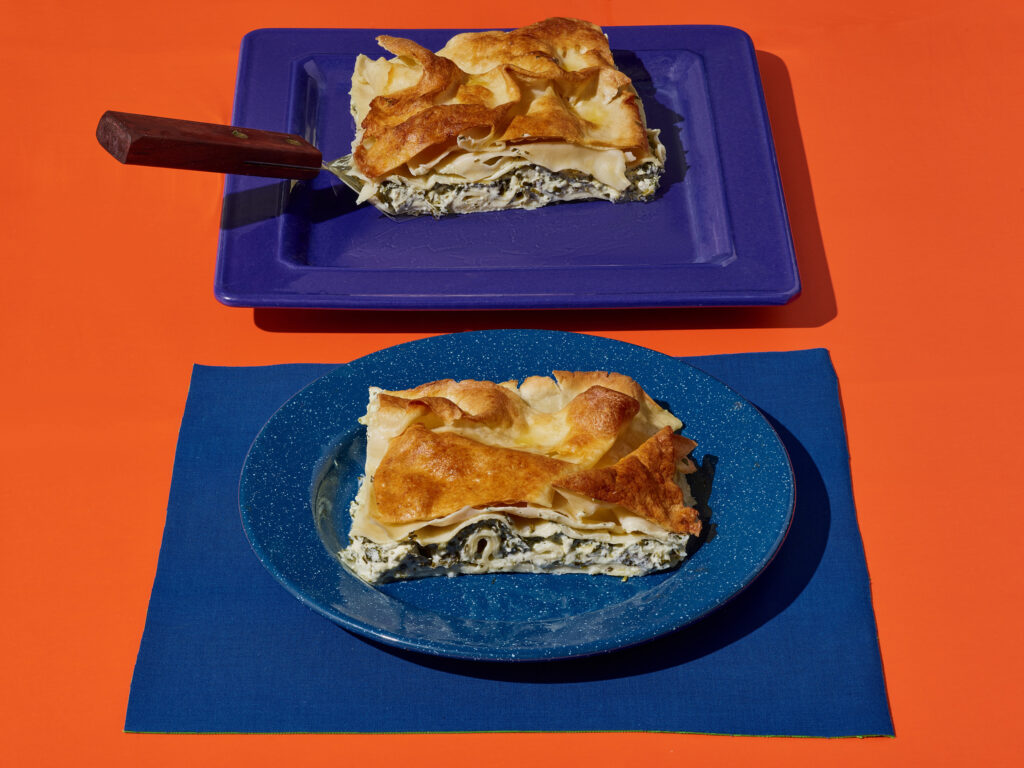
Despite being an object of national pride, the burek wasn’t unique to the Ottomans, and its origin is much humbler than the sumptuous table of the Sultan. The Turkish nomads baked the dough on a bonfire and carried that tradition with them from Beijing to Barcelona, from Modena to the Maghreb. Although it found its way to the tables of khans and kings, it remains a culinary testimony to generations of people who migrated, roamed and conquered, taking their culinary culture with them.
The burek is a symbol of the hard lives of nomadic shepherds. It required few ingredients: butter and cheese made by the shepherds from goat and cow’s milk, wild parsley from the plains, and grains bought or traded in the markets. The baking method, on a saj (a convex pan) placed over a bonfire or on hot stones, required little time and resources. On the other hand, the invention of burek may be perceived as expressing a wish for a more stable life. The Turkish tribes were proud of their culture and life, yet they could not help but envy the comfortable life of the cities, particularly the light and fluffy oven-baked bread they saw in the markets. Charles Perry, an expert on the culinary history of the Islamic world, writes in the book “A Soup for the Qan” that they developed “an obsessive interest” in recreating it. As they lacked ovens and sufficient fuel, they couldn’t, but managed to imitate its fluffiness by layering dough, which they filled with savory fillings and finally fried.
It seems this preparation method also accounts for the pastry’s name. According to Andreas Tietze, a researcher of Turkic languages, it comes from a Persian word (بورک), referring to any yufka-based pastry; it is derived from the Turkic root bur — to twist — which describes the twisting of the yufka “leaves,” or layers of dough.
Burek, Boureki, Chebureki
In the beginning of the seventh century AD, the Göktürks, the Turkish nomads, began moving west across Central Asia, taking their preferred pastry with them. Once the burek had left the steppes, it began to change. New fillings appeared, made from local ingredients that appealed to palates of new consumers: anchovies in the Black Sea city of Trabzon, and Eremurus, a wild plant, in mountainous Erzurum in what is now western Turkey.
As the Ottoman Empire expanded eastward and westward, the burek acquired the status of a national dish. At the beginning of the 16th century Constantinople, borek bakeries outnumbered other bakeries four to one and street stands sold trays of the pastry. Burek was served in the homes of common people, as well as on the table of the Grand Vizier. It became a matter of national pride, and the chief royal burek baker was one of the most important positions in the court of the Ottoman Sultan.
Eventually, versions of burek were adopted across all the lands under Ottoman rule and many of the places the empire had close commercial ties to. In Greece and other parts of the Balkans, “boureki” assimilated into the local kitchen. In Bosnia, local cooks filled the pastry with meat, cottage cheese, spinach or potatoes and formed it into a spiral. In Crete, “boraki” was filled with zucchini and feta, while the Tartars filled a flatbread called chebureki with mutton, onion and spices; and when the empire spread to North Africa, local versions began appearing in Tunisia and Algeria.
The Jewish Bourekas
The Jewish story of bourekas begins about 40 years after the conquest of Constantinople in 1453, with the Spanish Expulsion on the other side of the Mediterranean. Some of the expelled Jews of Andalucia found refuge in Italy, others in Egypt and the Levant; but the majority settled in Constantinople, the capital of the Ottoman Empire.
Like all immigrants, they missed the food of the home they left behind, and did their best to preserve it. At first, they avoided the burek and preferred their beloved empanadas. But with time, they adopted it and created a hybrid of the two: the boureka, with the typical “a” ending of feminine Spanish nouns. With a thicker dough than that of the burek, it was shaped into a semi-circle and stuffed with various fillings. In order to prevent confusion and keep kosher, dairy and meat bourekas were sprinkled with different toppings.
In the 18th and 19th centuries, the Ottoman attitude to Jews changed, which led to major migration. Most of the migrants fled to cities with large Jewish populations in modern-day Italy, such as Venice, Ferrara, and Modena. They brought along the boureka, which was gladly adopted by the locals who gave it a local name, burriche.
Many Jews stayed in Turkey and the bourekas, along with boyoz and bulemas (known as kol boregi in Turkish), became associated with them and considered a symbol of hospitality, a comfort food and proof of a cook’s culinary skill. Boyoz (from the Spanish word bollos, meaning buns) are an improved version of a Sephardic dish called bollos de pane: leftover bread kneaded to make dough, seasoned with salt and pepper, sometimes stuffed with cheese, and fried in oil. With time, Jews with roots in Izmir began making this dish from fresh buttery dough, which they rolled into a log, cut into circles, and fried or baked in the oven.
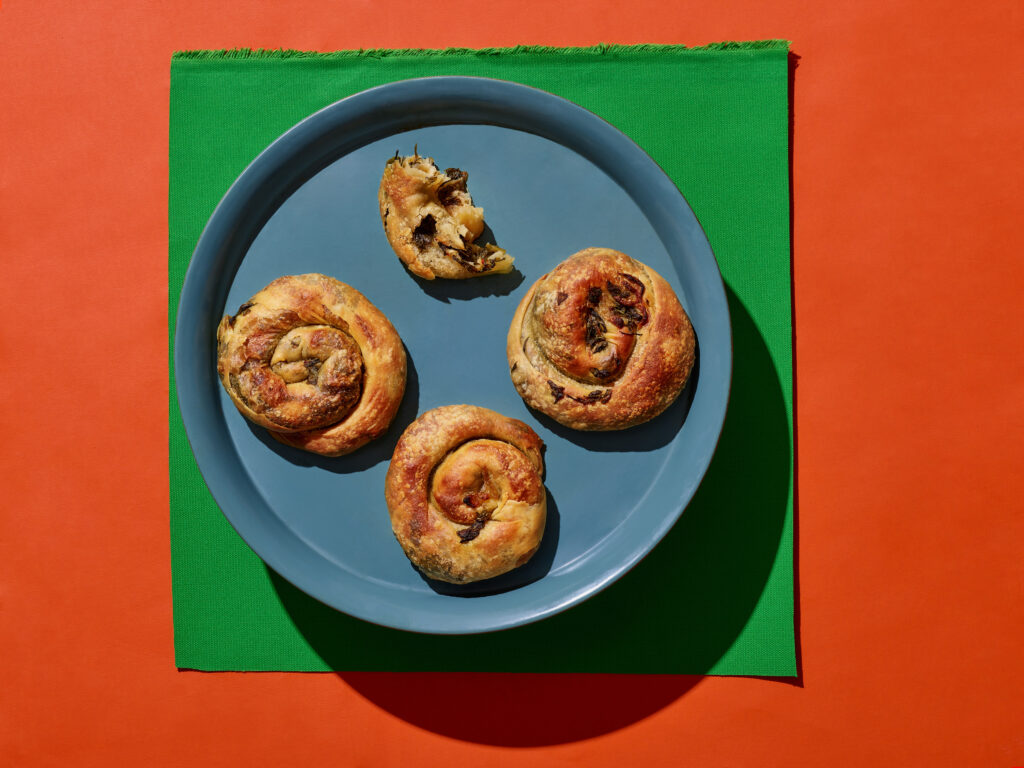
Bulemas, also known in Israel as Turkish bourekas or shablulim (snails), are made from thin dough rolled with cheese, spinach, or eggplants, and twisted into a spiral. They are also sometimes mistakenly called boyoz – it is believed the Jews of Rhodes, who maintained close contacts with Jews across the water in Izmir, are responsible for the confusion due to the similarity between the pastries.
Triangle or Square Bourekas? From Sammy Bourekas to Boutique Bakeries
Filled with potatoes, cheese, spinach, or mushrooms, sprinkled with sesame or poppy seeds, bourekas conquered Israel’s tables: no birthday party or shiva, a Shabbat breakfast or even government meeting is complete without a pile of borekasim (the Hebrew plural). Debates over where to find the best bourekas are no less emotional that those dedicated to hummus, but the fact that the majority of olim or immigrants from the Balkans landed in Haifa and Jaffa clearly gave these port cities an advantage, giving rise to local institutions, such as Bourekas Penso and Leon & Sons.
The expansion of the Israeli bourekas is largely attributed to Sammy Bourekas, the well-known bourekas chain founded by Sammy Alkolombris, the son of Turkish parents who migrated to Bulgaria and later to Israel. In 1948, Sammy and his wife began making butter-based spinach bourekas, which they sold from a cart on the streets of Jaffa. Business thrived, and in 1953 the couple opened what would become the chain’s first branch. Large crowds came to enjoy bourekas with a glass of ayran, a refreshing Turkish yogurt drink. Franchise branches began opening all around Israel: they received frozen bourekas from the factory in Bat Yam, which margarine replaced the butter for cost-saving reasons.
In the late 1970s, supermarket bakeries started selling bourekas, paving the pastry’s way into every home in Israel — Ashkenazi or Sephardi, Arab or Jewish. Before long, companies began manufacturing and selling frozen bourekas for home baking; potatoes, mushrooms, and pizza bourekas joined the classic cheese and spinach versions, and the transformation of bourekas into a fast and easy food for hosting was complete.
In the 1970s and 1980s, bourekas also made a surprising appearance as a guest star of Israeli weddings, in which parve mushroom sauce was ceremoniously poured over meat-filled bourekas (the custom of serving meat bourekas at weddings likely comes from Turkey, Iraq, and North Africa). “The Jewish Wedding Cookbook” by Nomi Abeliovich and Ofer Vardi mentions a 1971 sketch by the Israeli dramatist Hanoch Levin in which a couple tries to guess what will be served at the wedding they are about to attend — bourekas or chicken legs.
The naturalization process of bourekas is also reflected in the cookbooks of the times: the “Folkloric Cookbook,” a 1964 volume by Moli Bar-David includes a “Sephardic” bourekas recipe, with options to use strudel dough, shortcrust pastry or a simple noodle dough; the dough contains margarine, and the stuffing is based on caciocavallo cheese. In the 1969 book “The Art of Home Cooking” by Ruth and Eliezer Markin, there’s a recipe for triangular bourekas filled with salty cheese, with an option of using store-bought dough; the recipe is attributed to Mizrahi Jews. In the 1970s, however, bourekas are already presented as an everyday food with no clear ethnic associations: in Ruth Sirkis’s 1975 “Children Cooking” there is a recipe for triangular cheese bourekas from store-bought puff pastry, and a similar recipe appears in her “From the Kitchen with Love” of the same year.
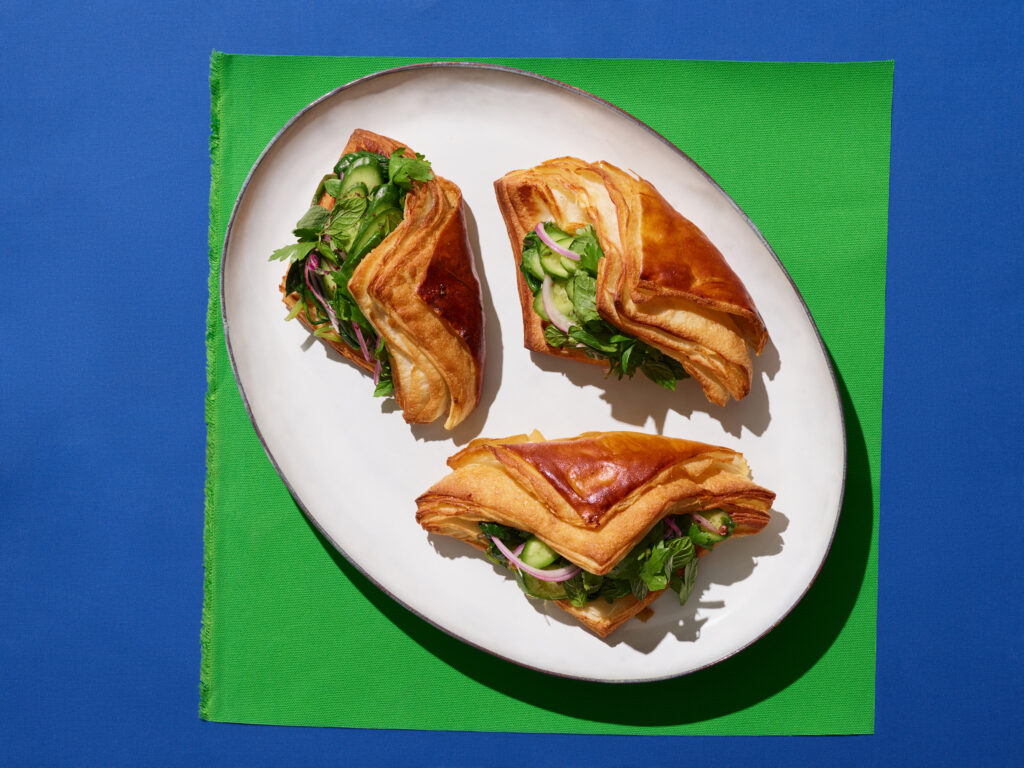
The relation between form and filling, going back to the time of the Ottoman Empire, was maintained and in 2013, the chief rabbi of Israel decided that bourekas needed to be made in specific shapes to be kosher: dairy bourekas can only be triangular, whereas parve bourekas will be rectangular. Besides a wish to prevent religious confusion, the reason, they stated, was food sensitivities and allergies: cheese bourekas that weren’t shaped into triangles were “life threatening.” The decision raised some protest among bakeries and factories, and its degree of enforcement remains unclear.
With bourekas becoming an inseparable part of Israel’s culinary culture, it is no wonder that in recent years they began making appearances at hot restaurants and boutique bakeries. Chefs gave their own spin to the classic pastry and Israeli diners fell in love with butter-rich bourekas made from croissant dough and Michael Gartofsky’s crab su burek at Michael Local Bistro with its delicate leek filling.
